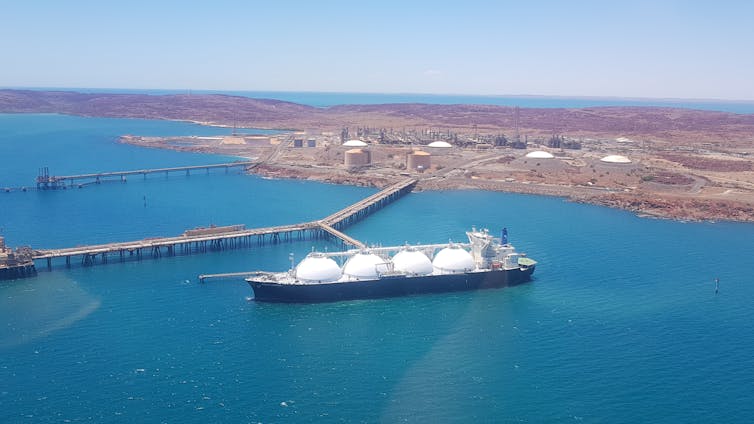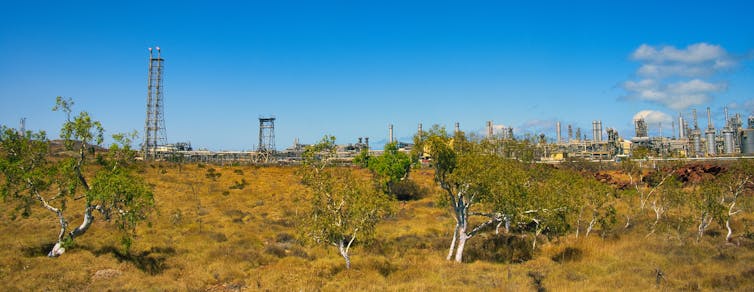Labor approves Woodside's North West Shelf extension: 'a prelude to approval for Woodside's Browse Project carbon bomb'
One of the world's leading rock art specialists has accused the WA government of producing "propaganda" to support its view that Woodside's controversial North West Shelf gas project should be allowed to extend, labelling government-produced documents a "disgrace to Australian science".
On Friday the WA government released a report into one of the world's most significant and dense collections of ancient petroglyphs, on the Burrup Peninsula (Murujuga) near Karratha, which are thought to be thousands of years old.
University of Western Australia professor of archaeology Benjamin Smith said the 800-page report found rock art closest to industry had been most degraded and recent industry was to blame — details he said the executive summary, which he states was produced by the government — failed to mention.
Another leading scientist, Emeritus Professor Adrian Baddeley, has expressed "grave concern" about "unacceptable interference" in a major study of the impacts of industrial emissions on ancient Aboriginal rock carvings in a complaint obtained by the ABC.
The West Australian government released the long-awaited results, completed in May 2024, from its ongoing
Rock Art Monitoring Program, which is studying petroglyphs on the Burrup Peninsula, or Murujuga, near Karratha in WA's north.
The five-year study was trying to determine whether industrial pollution has degraded Indigenous rock carvings thought to be 40,000 years old. The $27 million rock art monitoring project was led by the WA government in collaboration with the Murujuga Aboriginal Corporation, using experts from Curtin University.
See:
Technical report COPP21065-REP-G-105, revision 2
See ABC reports:
The latest results were considered by federal Environment Minister Murray Watt, as part of his ruling on whether to approve a 45-year licence extension of Woodside's North West Shelf LNG facilities on the Burrup Peninsula. The project was approved by the new 'Minister for the Environment' and announced as such on Wednesday May 28.
''Following the consideration of rigorous scientific and other advice including submissions from a wide cross-section of the community, I have today made a proposed decision to approve this development, subject to strict conditions, particularly relating to the impact of air emissions levels from the operation of an expanded on-shore Karratha gas plant.
In making my proposed decision I was required to consider:
- the potential impacts of extending the life of the plant on the national heritage values of nearby ancient rock art, and
- economic and social matters concerning the proposed development.
Based on the evidence before me and the Department’s recommendations, my proposed decision is subject to strict conditions.
My responsibility is to consider the acceptability of the project's impact on protected matters. In this case, the impact of air emissions on the Murujuga rock art that forms part of the Dampier Archipelago was considered as part of the assessment process. I have ensured that adequate protection for the rock art is central to my proposed decision.'' Minister Watt's statement says
Minister Watt had been in WA last week meeting with stakeholders, including the Cook government, ahead of the decision and a coming rewrite of the laws governing environmental approvals.
Greens senator Sarah Hanson-Young said the minister had "failed at the first hurdle".
"What the environment minister has done today is protected the big gas corporation Woodside and foreign-owned gas companies that will take these exports, rather than protecting Australia's environment or climate," Senator Hanson-Young said.
Greenpeace chief executive David Ritter said the approval was a "terrible decision".
"The North West Shelf facility is one of the dirtiest and most polluting fossil fuel projects ... despite what the gas lobby says, the reality is we don't need more polluting gas," Mr. Ritter said.
Greenpeace's WA campaign lead Geoff Bice said in a statement;
"The primary purpose of Woodside's North West Shelf extension is to process gas from the Browse gas field underneath Scott Reef — the minister should be looking at these gas mega projects as a whole,"
Last week Western Australia's environmental watchdog took the unusual step of reopening public consultation to Woodside's $30 billion Browse joint venture project.
Browse is Australia's largest untapped conventional gas resource, which Woodside is hoping to develop. The energy giant has made an application to WA's Environmental Protection Authority (EPA) to make changes to its proposal. Climate groups have labelled Browse a "carbon bomb", claiming the project could lead to emissions of up to 1.6 billion tonnes of carbon dioxide equivalent over its lifetime — an amount three times Australia's annual pollution output.
The Conservation Council WA has reaffirmed its rejection of Woodside’s Browse gas proposal, even in light of revised plans before the WA Environmental Protection Agency (EPA), which it says simply “tinkers around the edges”.
These changes include reducing the size of the development envelope to 78km2, to avoid overlapping parts of the heritage-listed Scott Reef.
Executive Director Matt Roberts said the revision was a “smoke and mirrors exercise” and in no way altered the threat posed by the Browse proposal to the fragile and pristine Scott Reef.
“Drilling will still be taking place unacceptably close to this unique marine ecosystem, which includes Sandy Islet, a critical nesting ground for endangered green sea turtles. Gas drilling is highly likely to cause subsidence of the ocean floor, potentially submerging this tiny atoll altogether,” Mr Roberts said.
“And as the revised proposal states, there is no change to the area of direct or indirect seabed disturbance estimates; subsidence is not addressed in any detail.
“While Woodside has significantly lowered the envelope of its drilling field, we’re still talking about an area four times the size of Rottnest Island (Wadjemup). Its initial plans for a 1,220km2 envelope was all about going in with outrageously large number, then scaling the project back to paint itself as a good corporate citizen.
“There is no reduction in the amount of gas they plan to extract from beneath this unique marine habitat, or the emissions that will be generated by the project. In essence, nothing has changed, Woodside has simply wrapped it up in a nice green ribbon.”
Mr Roberts said the WA EPA has already found the Browse proposal poses unacceptable risks to endangered pygmy blue whales, the green sea turtle and other threatened marine species at Scott Reef.
“Woodside’s revised proposal does nothing to mitigate the risk that gas extraction could cause the seabed to subside, potentially rendering Sandy Islet underwater and unusable for turtle nesting.
“Worst of all, Woodside’s Browse Gas proposal still entails the risk of a major oil spill catastrophically impacting the reef.
“In 2009, the Montara oil spill almost reached Scott Reef, which was only saved thanks to a chance change in prevailing winds and tides. At the start of this year, Santos was found guilty of another oil spill off the Pilbara coast that killed dolphins.
“Just two days ago, the offshore oil and gas regulator ordered Santos to stop drilling for their Barossa gas project due to a failure in the equipment that prevents oil spills from occurring. Offshore oil and gas drilling is inherently dangerous.
“And yet Woodside is comfortable labelling the risk to Scott Reef from an oil spill as ‘only a mere theoretical possibility.’ If a spill occurs, the impacts could be catastrophic.
“This revised proposal is simply artful deception – gambling with the future of Australia’s largest offshore coral reef, a haven for marine life found nowhere else on earth - that could result in catastrophic impacts that do irreparable damage to this pristine wilderness forever.
“There is no way to mitigate the unacceptable risks Browse gas poses to Scott Reef. The proximity of the project to the incredible natural values of the Scott Reef system which are at risk from oil spills, subsidence and disturbance from the operations is untenable. The only option is to reject it,” Mr Roberts added.
See ABC report:
Woodside's North West Shelf approval just a stepping stone to enable Browse project
The Climate Council has labelled the Albanese Government’s approval of the North West Shelf gas extension a failure of leadership.
''The decision to extend the life of Australia’s largest mainland gas facility until 2070 locks in more than 4 billion tonnes of climate pollution. That is equivalent to a decade of Australia’s annual emissions. It gives proponent Woodside the green light to keep operating one of the country’s most polluting fossil fuel projects until 2070.'' the Climate Council stated
Former North West Shelf Manager at BP Greg Bourne said: “Extending the North West Shelf will haunt the Albanese Government. They’ve just approved one of the most polluting fossil fuel projects in a generation, fuelling climate chaos for decades to come. This single project will unleash more than four billion tonnes of climate pollution. It undoes the good work they’ve done on cutting climate pollution and betrays the mandate Australian voters just gave them.
“The global market is already awash with gas. It is rubbish to say that Australia needs this gas when the lion’s share is marked for export and none of it will be used on the East Coast. It’s bad for the climate, bad for Australia’s economy, and completely out of step with where the world is heading.”
Climate Council CEO Amanda McKenzie said: “Communities in NSW are starting the clean-up after record-breaking floods. It is shocking that at the same time the Albanese Government has approved this massive climate bomb as its first act of this term of government. They’ve just opened the floodgates on over 4 billion tonnes of climate pollution.”
“Peter Dutton promised to approve this project before the last election. Voters rejected Dutton. Why would the Albanese Government take Dutton’s lead on climate policy? Approving the North West Shelf extension leaves a polluting stain on Labor’s climate legacy. Australians voted for a renewable-powered future, not more climate pollution and destruction.
“If the Government is actively making the climate crisis worse it must explain to communities, like those experiencing flooding right now, how it will protect them from more frequent and forceful extreme weather events.”
This project marks the Albanese Government’s 27th coal, oil or gas approval since taking office. It is the most polluting of them all.
Key facts on North West Shelf:
- Gas is a polluting fossil fuel: It’s made up mostly of methane, which is a potent greenhouse gas. Gas accelerates the climate crisis when it is released or burnt. When exported, it’s just as bad for our climate as coal.
- This project is not needed to support renewable power in Australia. Most of it will be exported, and in WA where the project is located: only 0.7 – 1.0% of WA’s gas supply is needed for electricity generation in the state over the next nine years. WA has more than enough gas to meet this need. Nationally, there is a small and declining role for gas in the switch to clean energy, and it is wrong to claim this project will play a role.
- Over its 45-year life, the project would lead to over 4 billion tonnes (gigatonnes) of climate pollution. This is more than double the two billion tonnes of climate pollution associated with the Coalition’s nuclear scheme to 2050.
- This is equivalent to 10 years of Australia’s current climate pollution, and will contribute to more intense and frequent unnatural disasters that are harming Australians.
- While most of the gas will be exported, the pollution from gas extraction and processing is expected to be 7.7 million tonnes per year – equivalent to the annual pollution from a coal-fired power station or 2.8 million cars. That would make it Australia’s second most polluting fossil fuel facility.
- UNESCO has warned that industrial emissions from this gas facility are damaging 50,000-year-old Indigenous rock art. Instead of protecting the globally significant heritage site at Murujuga, the Albanese Government has waved through decades more pollution.


![]()
